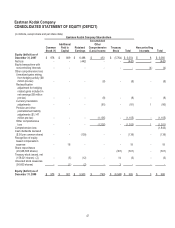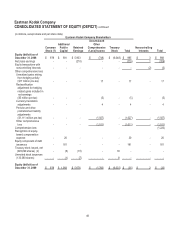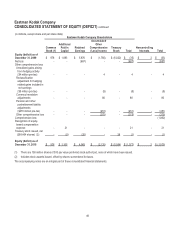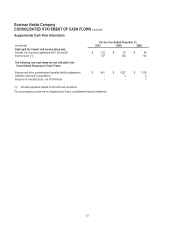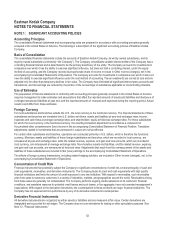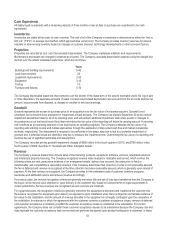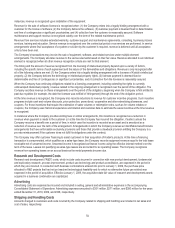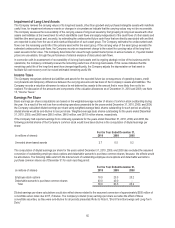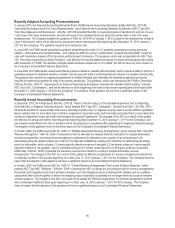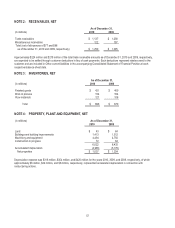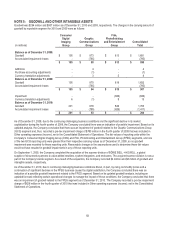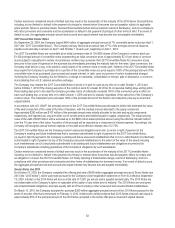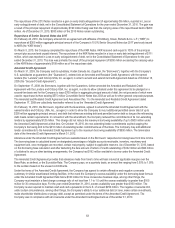Kodak 2010 Annual Report Download - page 55
Download and view the complete annual report
Please find page 55 of the 2010 Kodak annual report below. You can navigate through the pages in the report by either clicking on the pages listed below, or by using the keyword search tool below to find specific information within the annual report.53
Cash Equivalents
All highly liquid investments with a remaining maturity of three months or less at date of purchase are considered to be cash
equivalents.
Inventories
Inventories are stated at the lower of cost or market. The cost of all of the Company’s inventories is determined by either the “first in,
first out” (“FIFO”) or average cost method, which approximates current cost. The Company provides inventory reserves for excess,
obsolete or slow-moving inventory based on changes in customer demand, technology developments or other economic factors.
Properties
Properties are recorded at cost, net of accumulated depreciation. The Company capitalizes additions and improvements.
Maintenance and repairs are charged to expense as incurred. The Company calculates depreciation expense using the straight-line
method over the assets’ estimated useful lives, which are as follows:
Years
Buildings and building improvements
5-40
Land improvements
20
Leasehold improvements
3-20
Equipment
3-15
Tooling
1-3
Furniture and fixtures
5-10
The Company depreciates leasehold improvements over the shorter of the lease term or the asset’s estimated useful life. Upon sale
or other disposition, the applicable amounts of asset cost and accumulated depreciation are removed from the accounts and the net
amount, less proceeds from disposal, is charged or credited to net (loss) earnings.
Goodwill
Goodwill represents the excess of purchase price of an acquisition over the fair value of net assets acquired. Goodwill is not
amortized, but is required to be assessed for impairment at least annually. The Company has elected September 30 as the annual
impairment assessment date for all of its reporting units, and will perform additional impairment tests when events or changes in
circumstances occur that would more likely than not reduce the fair value of the reporting unit below its carrying amount. A reporting
unit is defined as an operating segment or one level below an operating segment. The Company estimates the fair value of its
reporting units utilizing income and market approaches through the application of discounted cash flow and market comparable
methods, respectively. The assessment is required to be performed in two steps, step one to test for a potential impairment of
goodwill and, if potential losses are identified, step two to measure the impairment loss. Determining the fair value of a reporting unit
involves the use of significant estimates and assumptions.
The Company recorded pre-tax goodwill impairment charges of $626 million in the fourth quarter of 2010, and $785 million in the
fourth quarter of 2008. See Note 5, “Goodwill and Other Intangible Assets.”
Revenue
The Company’s revenue transactions include sales of the following: products; equipment; software; services; integrated solutions;
and intellectual property licensing. The Company recognizes revenue when realized or realizable and earned, which is when the
following criteria are met: persuasive evidence of an arrangement exists; delivery has occurred; the sales price is fixed or
determinable; and collectability is reasonably assured. If the Company determines that collection of a fee is not reasonably assured,
the fee is deferred and revenue is recognized at the time collection becomes reasonably assured, which is generally upon receipt of
payment. At the time revenue is recognized, the Company provides for the estimated costs of customer incentive programs,
warranties and estimated returns and reduces revenue accordingly.
For product sales, the revenue recognition criteria are generally met when title and risk of loss have transferred from the Company to
the buyer, which may be upon shipment or upon delivery to the customer site, based on contract terms or legal requirements in
certain jurisdictions. Service revenues are recognized as such services are rendered.
For equipment sales, the recognition criteria are generally met when the equipment is delivered and installed at the customer site.
Revenue is recognized for equipment upon delivery as opposed to upon installation when there is objective and reliable evidence of
fair value for the installation, and the amount of revenue allocable to the equipment is not legally contingent upon the completion of
the installation. In instances in which the agreement with the customer contains a customer acceptance clause, revenue is deferred
until customer acceptance is obtained, provided the customer acceptance clause is considered to be substantive. For certain
agreements, the Company does not consider these customer acceptance clauses to be substantive because the Company can and
does replicate the customer acceptance test environment and performs the agreed upon product testing prior to shipment. In these






